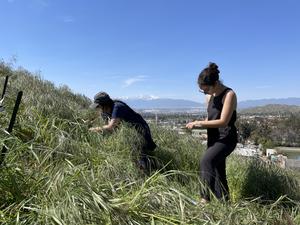Revitalizing California’s Ecosystems: The Impact of Raking on Plant Diversity
Battling Invasive Grasses for Native Wildflowers
California is facing a significant challenge as its indigenous wildflower populations are being overwhelmed by excessive layers of dead invasive grass species. A recent investigation conducted by UC Riverside reveals that a straightforward technique—raking these accumulated detritus—can promote biodiversity and mitigate fire hazards.
Published in the journal Restoration Ecology, this study explored if removing thatch—a layer formed by dead leaves and organic debris—could facilitate the germination of native plant seeds. The research compared raking to various other approaches for managing invasive grasses, such as controlled burns, hand weeding, and chemical herbicide application. Raking stands out as a less laborious and more environmentally sustainable method.
“Native seeds typically land on thick thatch layers where they struggle to sprout. By raking, we let sunlight penetrate through, giving these plants an opportunity to thrive,” explained Marko Spasojevic, an associate professor of plant ecology at UCR who contributed to the study.
Methodology: Raked vs. Unmanaged Plots
In grassy areas neighboring the UCR campus, researchers established paired plot grids—one that was raked and another left untouched—to observe shifts in plant communities over three years. The outcomes demonstrated not only an increase in overall plant biodiversity but also a reduction in invasive grass species such as ripgut brome while promoting both native and non-native wildflowers known collectively as forbs.
Ripgut brome is notorious among grazers due to its sharp hairs which can cause harm when consumed. “This grass poses serious risks for livestock like sheep and cattle,” noted Spasojevic while highlighting the benefits observed among native flower species like common fiddleneck prevalent in Riverside following raking efforts.
Understanding Trade-offs
Despite its advantages in controlling invasive grasses, raking has also led to increased populations of certain foreign wildflowers—including mustard—that can be quite aggressive themselves.
“Raking resulted in about a 5% rise in native wildflower presence along with a 7% to 10% increase in exotic types,” commented Advyth Ramachandran, who played a pivotal role during his undergraduate days at UCR before continuing his studies at the University of Colorado Boulder. “Nonetheless, this doesn’t undermine its value; it’s an easy-to-implement low-cost approach forming part of initial restoration efforts.”
A Community Driven Initiative
The origin story behind this project dates back many years; it harkens back to formative biology courses from the 1980s which created initial plots now repurposed after being dormant for years. During COVID-19 lockdowns, Ramachandran along with fellow UC Riverside students revitalized these sites collaborating through SEEDS—a student-led club focused on ecological research.
“We started from nothing: drafting methodologies, identifying flora species involved whilst engaging over 25 undergraduate participants throughout this venture,” recalled Ramachandran. “It’s uncommon for undergraduates leading publishable research initiatives.”
Spasojevic attributes much of their success to how accessible their project was; situated right on campus meant students could participate between classes reducing participation barriers while fostering rich mentorship opportunities within academia. Remarkably still active today through data collection into their fifth consecutive year demonstrates ongoing student engagement with SEEDS initiative projects.
Significance Beyond Academia
The implications derived from their findings hold immense value particularly sought-after by land management professionals aiming toward economical solutions conducive toward restoring natural flora diversity across grasslands alongside coastal sage scrub ecosystems frequently found throughout Southern California.
Native plants fulfill essential roles providing resources crucially needed by local wildlife while aiding pollinators including bees crucially needed within our food systems whilst fortifying soils against erosion trends exacerbated primarily via dense flammable layers produced solely by invading grasses thriving unchecked during drought conditions synonymous with climate change challenges today affecting overall ecosystems health significantly talking positively about human impacts too!
“This endeavor emphasizes how minor actions like simple rakes yield profound consequences positively enhancing our natural habitats,” concluded Ramachandran emphasizing potential pathways forward rehabilitating California’s dwindling but resilient landscapes elegantly resting upon shared commitments community-wide initiatives advancing environmental health sustainability long-term!






